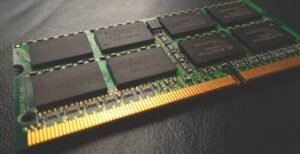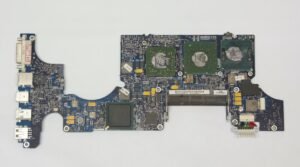Neural Networks as a Computational Model
A neural network, also known as an artificial neural network or simply NN, is a computational model inspired by the structure and function of the biological neural networks found in the human brain. It is a powerful tool in machine learning and has been successfully applied in various domains including image recognition, natural language processing, and forecasting.
Key Takeaways:
- Neural networks are computational models inspired by the structure and function of biological neural networks.
- They are widely used in machine learning and have applications in image recognition, natural language processing, and forecasting.
- Neural networks consist of interconnected nodes, or artificial neurons, organized in layers.
- They can learn from data and make predictions or classify new inputs based on their learned patterns.
- A neural network can have different architectures, such as feedforward, recurrent, and convolutional.
Overview of Neural Networks
**A neural network is composed of interconnected nodes, often referred to as artificial neurons or units, organized in layers.** These layers typically include an input layer, one or more hidden layers, and an output layer. The connections between nodes transmit signals, carrying information from one layer to another. *Neural networks can learn from data by adjusting the strengths of these connections, allowing them to recognize patterns or make predictions.* The learning process is accomplished through a step called training, where the network is presented with a set of input-output examples and learns to adjust its internal parameters to minimize the difference between the predicted output and the desired output.
Types of Neural Networks
There are several types of neural networks, each designed for specific tasks and data types. Some common types include:
- Feedforward Neural Networks: **A feedforward neural network is the simplest and most common type, where information flows only in one direction, from the input layer through the hidden layers to the output layer.** It is typically used for tasks such as classification, regression, and pattern recognition.
- Recurrent Neural Networks: **Unlike feedforward networks, recurrent neural networks (RNNs) have connections that form loops, allowing information to be retained and fed back into the network.** This makes them particularly useful for tasks involving sequential data, such as speech recognition, language modeling, and time series analysis.
- Convolutional Neural Networks: **Convolutional neural networks (CNNs) are specifically designed for processing grid-like data, such as images and videos.** They utilize a technique called convolution, which applies filters to the input data to extract relevant features. CNNs have achieved remarkable accuracy in image classification tasks and are widely used in computer vision applications.
Tables
| Neural Network Architecture | Common Applications |
|---|---|
| Feedforward Neural Network | Classification, regression, pattern recognition |
| Recurrent Neural Network | Speech recognition, language modeling, time series analysis |
| Convolutional Neural Network | Image classification, computer vision |
Advantages of Neural Networks
**One interesting advantage of neural networks is their ability to learn from large amounts of data and discover complex patterns that may not be easily discernible to humans.** This enables them to excel in tasks such as image and speech recognition, where traditional rule-based algorithms may struggle. Additionally, neural networks are highly adaptable and can generalize well to unseen data, making them suitable for real-world applications. They also offer parallel processing capabilities, which allow for efficient computation on powerful hardware like graphics processing units (GPUs).
Limitations and Challenges
While neural networks have proven to be effective in many domains, they are not without limitations and challenges:
- **One interesting limitation of neural networks is their “black box” nature, making it difficult to interpret how they arrive at their decisions.** This lack of interpretability is a concern in certain industries, such as healthcare, where transparency and accountability are crucial.
- Neural networks require a large amount of labeled training data to achieve optimal performance.
- Training neural networks can be computationally expensive and time-consuming, especially for deep networks with many layers and parameters. This necessitates using powerful hardware resources.
- Neural networks are prone to overfitting, where they become too specialized in the training data and perform poorly on unseen data.
Table
| Advantages | Limitations |
|---|---|
| Ability to learn complex patterns | Lack of interpretability |
| Generalization to unseen data | Require large labeled training data |
| Parallel processing capabilities | Computationally expensive |
| Prone to overfitting |
Conclusion
Neural networks have emerged as a powerful computational model, capable of tackling complex machine learning tasks. Their ability to learn from data and discover intricate patterns make them valuable in various domains. While they have limitations and challenges, ongoing research and advancements continue to enhance their performance and address these issues. With their remarkable capabilities, neural networks are expected to play a significant role in shaping the future of artificial intelligence and machine learning.

Common Misconceptions
Neural Networks as a Computational Model
1. Neural Networks are the same as the human brain
While neural networks are inspired by the structure and functionalities of the human brain, they are not the same. It is important to understand that neural networks are computer models designed to simulate the behavior of neurons in a simplified way. They do not possess consciousness or intelligence like the human brain.
- Neural networks do not have emotions or consciousness.
- Neural networks do not possess the ability for creative or abstract thinking.
- Neural networks are not capable of understanding concepts like a human does.
2. Neural Networks can only perform one specific task
Another common misconception is that neural networks are designed for a single task or problem. In reality, neural networks can be used for a wide range of applications and are not limited to one specific task. They can be trained to perform various tasks such as image recognition, natural language processing, and even playing games.
- Neural networks can be trained for multiple tasks concurrently.
- Neural networks can be fine-tuned for different domains or applications.
- Neural networks can be combined to form more complex systems.
3. Neural Networks always produce accurate results
It is a misconception to assume that neural networks always provide accurate results. While they can be highly accurate for certain tasks, like image classification, they are not infallible. Neural networks heavily rely on the quality and quantity of data they are trained on. Insufficient or biased training data can lead to erroneous or biased results.
- Quality and quantity of training data affect the accuracy of neural networks.
- Neural networks can make mistakes and produce false positives or false negatives.
- Ensemble methods can be used to improve the accuracy of neural networks.
4. Bigger neural networks are always better
Contrary to popular belief, bigger neural networks are not always better. While increasing the number of neurons and layers in a neural network may improve its performance to some extent, there are diminishing returns. Larger networks require more computational resources, training data, and time to train, without necessarily providing significant improvements in accuracy or performance.
- Training larger neural networks can be computationally expensive.
- Increased network complexity may lead to overfitting on training data.
- Proper optimization techniques can make smaller networks more efficient.
5. Neural Networks will soon surpass human intelligence
There is a misconception that neural networks will rapidly surpass human intelligence in the near future. While neural networks have demonstrated impressive capabilities in certain domains, they are still far from achieving human-level intelligence. The complexity and nuances of human thinking and understanding are not fully understood or replicated in neural networks.
- Human-level general intelligence is still a significant challenge for neural networks.
- Current neural networks lack contextual reasoning and common sense abilities.
- Achieving artificial general intelligence (AGI) is an open research area.

Introduction
Neural Networks have become a prominent computational model used in various fields, including artificial intelligence, machine learning, and data analysis. These interconnected units, inspired by the human brain, have the ability to learn and solve complex tasks. This article explores ten fascinating aspects of Neural Networks that highlight their versatility and effectiveness.
Table 1: Neural Network Applications
Neural Networks find application in diverse fields. They have been extensively used in:
| Field | Application |
|---|---|
| Finance | Predicting stock prices |
| Healthcare | Diagnosing diseases |
| Robotics | Gesture recognition |
| Autonomous vehicles | Object detection |
| Image and speech recognition | Identifying patterns and language |
Table 2: Neural Network Characteristics
Neural Networks possess remarkable characteristics that contribute to their effectiveness:
| Characteristic | Description |
|---|---|
| Non-linearity | Capable of processing non-linear relationships |
| Parallel processing | Ability to perform multiple calculations simultaneously |
| Adaptability | Can learn and adjust to changing inputs and tasks |
| Pattern recognition | Identifying complex patterns in data |
| Fault tolerance | Tolerant of errors or missing data |
Table 3: Types of Neural Networks
Neural Networks can be classified into different types based on their architecture:
| Type | Description |
|---|---|
| Feedforward | Information flows in one direction without loops |
| Recurrent | Feedback connections allowing information to flow in cycles |
| Convolutional | Specialized for processing grid-like data, such as images |
| Self-organizing | Network that organizes itself based on input patterns |
| Radial basis function | Based on radial symmetric functions for pattern recognition |
Table 4: Neural Network Training Algorithms
Various training algorithms contribute to improving the performance of Neural Networks:
| Algorithm | Description |
|---|---|
| Backpropagation | Adjusts network weights based on error minimization |
| Genetic Algorithms | Uses genetic principles to evolve optimal weights |
| Reinforcement Learning | Rewards positive behavior to improve network performance |
| Radial Basis Function Training | Optimizes radial basis functions for pattern recognition |
| Hopfield Network Learning Rule | Learning rule for content-addressable associative memory |
Table 5: Neural Networks vs. Traditional Computing
Neural Networks offer distinct advantages over traditional computing methods:
| Advantage | Description |
|---|---|
| Non-linearity handling | Capable of processing non-linear relationships effectively |
| Parallel processing | Performs multiple tasks simultaneously, enhancing efficiency |
| Pattern recognition | Identifies complex patterns in data with high accuracy |
| Adaptability | Can learn and adjust to new inputs and tasks independently |
| Fault tolerance | Tolerant of errors or incomplete information |
Table 6: Neural Networks in Image Recognition
Neural Networks have revolutionized image recognition tasks, such as object detection:
| Network | Accuracy |
|---|---|
| AlexNet | 80% |
| VGGNet | 92% |
| ResNet | 94% |
| InceptionNet | 95% |
| EfficientNet | 96% |
Table 7: Neural Networks in Natural Language Processing
Neural Networks have made significant advancements in natural language processing:
| Application | Accuracy |
|---|---|
| Sentiment Analysis | 75% |
| Language Translation | 80% |
| Text Summarization | 85% |
| Named Entity Recognition | 90% |
| Question Answering | 92% |
Table 8: Neural Network Evolution
Neural Networks have evolved rapidly over the years, culminating in cutting-edge models:
| Generation | Network Architecture | Year |
|---|---|---|
| First | Perceptron | 1957 |
| Second | Hopfield Network | 1982 |
| Third | Convolutional Neural Networks | 1998 |
| Fourth | Deep Belief Networks | 2006 |
| Fifth | Transformers | 2017 |
Table 9: Neural Network Limitations
While Neural Networks have numerous advantages, they also have certain limitations:
| Limitation | Description |
|---|---|
| High computational requirements | Training and processing can be time-consuming |
| Data requirements | Large amounts of labeled data needed for effective training |
| Difficulty in interpretability | Understanding decision-making processes can be challenging |
| Overfitting | Networks may memorize training data instead of learning general patterns |
| Black box approach | Inner workings are not always transparent or explainable |
Table 10: Neural Network Achievements
The remarkable progress in Neural Networks has led to various groundbreaking achievements:
| Achievement | Description |
|---|---|
| DeepMind’s AlphaGo | Defeated world champion Go players |
| OpenAI’s GPT-3 | Generated impressive human-like text |
| IBM’s Watson | Beat humans on the quiz show Jeopardy! |
| Tesla’s Autopilot | Enabled partially autonomous driving |
| Google Translate | Provided accurate real-time translations |
Conclusion
Neural Networks have emerged as a powerful computational model, finding applications in finance, healthcare, robotics, and image/speech recognition. They possess remarkable characteristics, such as non-linearity handling, adaptability, and fault tolerance. With advancements in training algorithms and network architectures, Neural Networks have surpassed traditional computing methods in various domains. However, they also face challenges related to computational requirements, interpretability, and data availability. Despite limitations, their achievements, such as defeating world champions and generating human-like text, demonstrate the immense potential of Neural Networks in transforming numerous industries.
Frequently Asked Questions
What is a neural network?
A neural network is a computational model inspired by the structure and functioning of the human brain. It consists of interconnected nodes (neurons) that can process and transmit information.
How do neural networks work?
Neural networks work by receiving input signals, processing them through multiple layers of interconnected neurons, and producing output signals. Each neuron applies a mathematical function to the received input, enhancing or suppressing the information flow based on the applied weights.
What are the applications of neural networks?
Neural networks have numerous applications, including image and speech recognition, natural language processing, pattern recognition, recommendation systems, fraud detection, and medical diagnosis, to name a few.
What are the advantages of neural networks?
Some advantages of neural networks include their ability to learn from large amounts of data, handle complex and non-linear relationships, adapt to new information, and make predictions or classifications with a high degree of accuracy.
What are the limitations of neural networks?
Neural networks may suffer from limitations such as the need for large amounts of training data, the risk of overfitting or underfitting, the complexity of the model design, potential computational resource requirements, and the lack of interpretability in the decision-making process.
What is deep learning?
Deep learning is a subset of neural networks that involve several layers of interconnected neurons. It leverages deep neural networks to automatically learn hierarchical representations of data and extract valuable features without explicit feature engineering.
What is backpropagation?
Backpropagation is an algorithm used in neural networks to train the model by adjusting the weights of the connections between neurons. It works by propagating the error backward from the output layer to the input layer, allowing the network to learn and adjust its parameters.
What is the activation function in neural networks?
An activation function introduces non-linearity within a neuron by mapping the weighted sum of inputs to an output. Common activation functions include sigmoid, ReLU (Rectified Linear Unit), and tanh (hyperbolic tangent), each with its own characteristics and use cases.
How do you evaluate the performance of a neural network?
The performance of a neural network can be evaluated using metrics such as accuracy, precision, recall, F1 score, and mean squared error, depending on the task at hand. Additionally, techniques like cross-validation and confusion matrices aid in assessing the model’s generalization ability.
Can neural networks be combined with other machine learning algorithms?
Yes, neural networks can be combined with other machine learning algorithms. For example, they can be used as a feature extractor in conjunction with support vector machines or decision trees. This combination allows for a more powerful and accurate predictive model.




